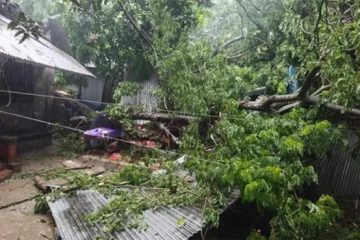Mindless use in Dhamrai farmlands causes death of 3 kids in a month; many others ill
 Excessive use of pesticides on farmlands in two villages of Dhamrai upazila caused death of at least three children last month.
Excessive use of pesticides on farmlands in two villages of Dhamrai upazila caused death of at least three children last month.
It also killed a number of calves, dogs and fowls.
Besides, 13 more children, all aged below seven, were hospitalised, while some farmers fell sick during the same period.
A committee formed by the Institute of Epidemiology, Disease Control and Research (IEDCR) under the health ministry reveals this in a primary investigation report.
Talking about reasons behind the recent deaths in Dhamrai’s Malancha and Naogakaith villages, IEDCR Director Dr Mahmudur Rahman told The Daily Star, “We are sure it was pesticide poisoning. And we think it’s happening in other parts of the country as well.”
During a visit to the villages yesterday, this correspondent found that the families did not yet know their kids had in fact died of toxic poisoning, not of any mysterious illness.
Abdus Samad, grandfather of Meem, a 32-month-old girl who died on April 2, told The Daily Star, “We had breakfast together that morning. We talked a lot and she did not show any symptoms of sickness. After some time, she went out, but came back seriously ill.”
Asked what she thought was the cause of her daughter’s death, Meem’s mother Asma Begum said, “The doctors could not diagnose the disease.”
During investigation, the IEDCR committee gathered that the farmers in the villages used furadan or carbofuran (recently banned in Kenya for being used in killing lions and other predators) on paddy fields.
Besides, some villagers were using organophosphate insecticides like cypermethrin, malathion and chlorpyrifos many times the recommended dose.
Local Agricultural Officer Khairul Alam said the farmers in Malancha and Naogakaith spray pesticides in amounts way more than what is safe.
Halim, an aubergine grower in Malancha, has applied eight to 10 kilograms of furadan and 63 bottles (120 ml each) of liquid pesticide on his .75-acre land.
“Using that much pesticide is highly dangerous. We don’t even recommend strong pesticides like furadan for eggplants. He should have used only 600 ml of liquid pesticide and that too in three phases,” said Khairul.
The IEDCR’s primary investigation found quite a few examples of overuse of pesticides.
For instance, Khaleque treats his chilli on a small piece of land with 500 grams of furadan. Barek applies three kilograms of furadan for his 2.57-acre paddy, while Shukur treats the edge of his field with rat poison.
Nizam of Malancha sprayed his mango trees with chlorpyrifos in the early morning of April 2. His daughter Meem plucked a mango from one of the trees at around 7:30am and died within an hour, the IEDCR report states.
Locals said most of the victims fell sick between April 2 and April 14. Each had a sudden onset of symptoms–reduced consciousness, frothy discharge, respiratory distress, constricted pupils and convulsions.
Before expiry, the dogs and calves were bellowing, jerking heads and off feeding, the IEDCR report reads.
“Initially, it was hard to detect what was wrong with the patients. But as symptoms emerged, we treated them for poisoning,” said Dr Nitya Gopal Chowdhury, medical officer (disease control) of Dhamrai upazila health complex.
Asked why the children are more prone to pesticide poisoning, he said, “It’s their weaker resistance to pesticides.”
He said none of the affected children’s breath however reeked of any chemicals, and it suggests they did not swallow pesticide grains.
Meanwhile, IEDCR has launched an awareness campaign against pesticides in those two villages.
It cautioned the villagers against letting their children go to the crop fields and using clay to make toys or ovens.
The IEDCR team has collected many biological and environmental samples including those of blood, urine, stool, cough and breast milk from villagers.
The samples have been sent abroad for further tests.




















